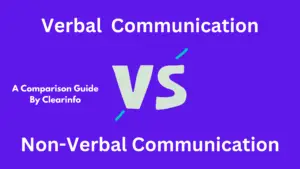Definition of grapevine communication
“Grapevine communication is an informal, unofficial, and spontaneous communication system that arises within an organization, characterized by the transmission of information through personal interactions rather than formal channels.” – Louis A. Allen, a prominent figure in the field of organizational communication.
What is grapevine communication?
Grapevine communication is an informal and unofficial method of communication within an organization or social group. It includes the exchange of information, gossip, speculations, and rumors among individuals using informal channels instead of official formal channels.
The term grapevine in communication originates from the way grapevines twist and intertwine, symbolizing how information can spread quickly and unpredictably.
Causes of grapevine communication:
- Absence of Formal Communication: When official communication channels fail to provide timely or sufficient information, people often rely on the grapevine to fill the gap.
- The desire for Social Interaction: Grapevine communication can be driven by the human need for social interaction and sharing information with others.
- Need for Confirmation or Validation: Employees might turn to the grapevine to seek confirmation or validation of rumors or news.
What are the characteristics and features of grapevine communication?
Key characteristics of grapevine communication:
- Informal Nature: Grapevine communication operates outside formal hierarchies, allowing any individual to participate, irrespective of their position or authority.
- Speed: Information travels quickly through the grapevine network, often outpacing formal channels, reaching a large audience in a short time.
- Unreliable Source: Due to its lack of verification, grapevine communication may spread inaccurate or false information, leading to confusion and misunderstandings.
- Satisfies Social Needs: Grapevine communication serves as a platform for informal bonding, opinion-sharing, and developing a sense of connection among individuals.
- Spontaneity: This form of communication emerges spontaneously from casual conversations, spreading naturally throughout the organization.
Diagram of grapevine communication
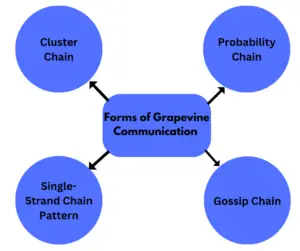
Examples of grapevine communication in an organization
Example 1.1
The Marketing Director and the Human Resources Manager in a company share a close friendship outside of work. During a casual conversation, the Marketing Director confides in the HR Manager about a significant upcoming organizational restructuring plan. This plan involves merging two departments and potentially laying off some employees.
The HR Manager, unaware that the restructuring plan has not been formally announced to all employees, shares this information with a few of their colleagues during a lunch break. Word of the impending restructuring starts to spread throughout the company through informal conversations, causing anxiety and uncertainty among employees who are not directly involved in the informal network.
Example 2.1
During a team lunch break, a group of colleagues discusses an upcoming project that hasn’t been officially announced yet. One team member overheard their manager talking about it in a private meeting, and the information starts spreading among the team members through informal conversations. As a result, some team members feel left out and wonder why they haven’t been informed directly by management.
Source for the example mentioned.
What are the types of grapevine communication?
Grapevine communication, being an informal and spontaneous form of communication, can take on various types or forms within an organization or social group. These types of grapevine communication are based on how information spreads and the direction it takes. Here are the main types:
1) Single-Strand Chain Pattern: In this form of grapevine communication, information flows linearly or sequentially from one person to another. It typically starts with one individual sharing information with another, who then shares it with someone else, and so on. This type of grapevine appears like a single-strand chain pattern, where the information flows in a single direction along a single strand.
Example of single-strand grapevine communication: Employee A shares a rumor with Employee B, who then shares it with Employee C, and so on.

2) Gossip Chain: A gossip communication network is characterized by the spread of rumors and personal information about individuals within the organization. This form of communication tends to be more focused on personal matters rather than work-related issues. Gossip can be harmful and may lead to a negative work environment if not managed properly.
Example of gossip chain communication: An employee from the marketing department shares a rumor with a friend in the finance department, who then shares it with their colleagues, and the information continues to spread across different departments.

3) Probability Chain: In this type, individuals selectively share information with others they believe are likely to be interested or affected by it. This form of grapevine communication is driven by the assumption that some people are more relevant recipients of certain information than others.
Example of Probability chain communication: An employee in the sales team shares information about a potential client with their colleagues but does not share it with employees from other departments.
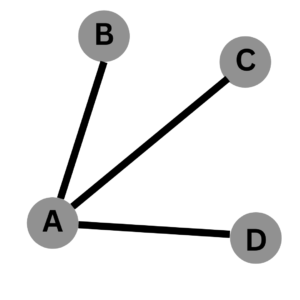
4) Cluster Chain: Cluster grapevine communication refers to situations where information spreads within specific groups or clusters of individuals who share close social connections or work closely together. It often results from the natural formation of sub-groups within a larger organization.
Example of cluster chain communication: A group of employees who frequently have lunch together share information within their group but may not necessarily share it with others outside the group.
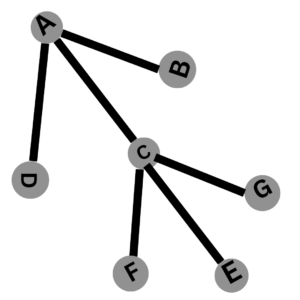
Overall. Understanding these types can help organizations manage grapevine communication more effectively and reduce the negative impact of rumors and misinformation.
Types of rumors present in grapevine communication
Rumors are a common element of grapevine communication, and they can take on various types or forms depending on their content and context. Understanding the types of rumors present in grapevine communication can help organizations address them more effectively and mitigate their negative impact. Here are the main types of rumors:
1/ Wedge Drivers Rumor: These rumors are aggressive, unfriendly, and damaging in nature. They often involve one entity trying to create a negative perception of another, such as one company spreading false information about another company’s products or services.
2/ Home Stretchers Rumor: These rumors emerge during periods of uncertainty and are aimed at anticipating final decisions or announcements. They serve to fill the informational gap and provide a sense of direction to individuals within the organization.
3/ Wish Fulfillment Rumor: Wish fulfillment rumors express the desires and hopes of those who circulate them. These rumors are generally positive and often activate creativity and innovation within the organization.
4/ Bogey Rumor: Bogey rumors arise from employees’ fears and anxieties, creating a sense of uneasiness among the workforce. These rumors often surface during challenging times, such as budget cuts or the possibility of layoffs, and can hurt employee morale and productivity.
Importance of grapevine communication in the workplace
Grapevine communication plays a crucial role in the workplace due to its several important aspects:
1/ Informal Innovation Hub: The grapevine can be an incubator of innovative ideas and suggestions. Employees may share creative solutions or improvements informally, which can be valuable for the organization’s growth.
2/ Identifying Emerging Issues: Grapevine communication can act as an early warning system for emerging issues within the organization. Managers can use the grapevine to identify potential challenges or conflicts and address them before they increase.
3/ Adapting to Organizational Culture: Understanding the grapevine allows managers to adapt their communication style to fit the organizational culture better. They can tailor messages in a way that resonates with employees, increasing the chances of successful communication.
4/ Informal Mentoring and Knowledge Sharing: The grapevine facilitates informal mentoring and knowledge sharing among employees. Experienced workers can pass on valuable insights and tips to newcomers, enhancing overall learning and development within the organization.
5/ Nurturing Leadership Skills: Grapevine communication can provide opportunities for emerging leaders to demonstrate their communication and management skills. They may naturally take on leadership roles within informal networks, contributing to their growth and development.
Overall, grapevine communication is a valuable and dynamic aspect of the workplace. When managed effectively, it can strengthen employee engagement, trust, and communication, contributing to a more cohesive and productive organization.
Where does grapevine exist in the organization?
Grapevine communication exists in various areas within an organization, cutting across different levels and departments. It grows in the informal networks of communication that employees naturally form while interacting with each other.
Here are some common places where grapevine communication can be found:
- Watercooler Conversations: Informal discussions that take place around water coolers, coffee machines, or common break areas are typical grounds for grapevine communication. Employees often exchange information and gossip during these casual encounters.
- Social Events and Gatherings: Office parties, team outings, and social gatherings provide opportunities for employees to interact outside of work-related contexts. During such events, grapevine gossip can excel as employees relax and engage in more honest conversations.
- Informal Meetings: Informal meetings or huddles that occur spontaneously among employees can be channels for grapevine messages. These meetings may happen in someone’s office, a common area, or even during lunch breaks.
- Off-Site Gatherings: Informal interactions and grapevine informal communication can extend to off-site gatherings, conferences, or industry events where employees from the same organization interact with colleagues from other departments or locations.
What is the impact of grapevine communication on an organization?
Grapevine in an organization can have both positive and negative effects, its impact on an organization is significant and should not be ignored. Key points to understand the impact of grapevine communication on an organization:
1/ Morale and Engagement: Grapevine communication’s positive rumors can lift employee spirits, while negative ones can lead to reduced motivation and increased anxiety.
2/ Trust and Credibility: The grapevine’s impact on trust is significant, as employees often trust informal grapevine information when they perceive it as more authentic, but repeated inaccuracies can weaken trust in both grapevine and formal communication channels.
3/ Reputation Management: Positive grapevine communication enhances an organization’s reputation, whereas negative grapevine communication can damage it both internally and externally.
4/ Informal Feedback Mechanism: Grapevine serves as an informal feedback channel in communication for employees to express concerns and ideas, allowing management to understand employee sentiments and improve policies or procedures.
5/ Conflict and Office Politics: Grapevine communication can lead to increased conflicts and contribute to office politics as personal biases influence the spread of information, potentially harming the organization’s interests.
How can managers use grapevine effectively?
Managers can use the grapevine effectively by recognizing its existence and importance as an informal communication channel within the organization. To utilize its potential, managers should actively listen to grapevine conversations, participate in informal interactions with employees, and show interest in their concerns and opinions.
By doing so, managers can gain valuable insights into employee sentiments, identify emerging issues, and assess the overall morale of the workforce. Managers need to provide regular updates and transparent information through formal channels to address any misinformation or rumors that may arise from the grapevine.
Moreover, By being approachable and demonstrating genuine interest in what employees have to say, managers create an atmosphere of trust and openness. This encourages employees to share their opinions and raise any issues they might be hesitant to address through formal channels. As a result, managers can stay informed about the pulse of the organization and understand any emerging challenges or opportunities that might not be immediately apparent in formal reports or meetings.
Lastly, managers should use the grapevine channel of communication as a complementary tool to enhance formal communication, rather than dismiss it entirely, to better understand the needs and perspectives of their team members.
How to control and manage grapevine communication?
Grapevine communication mainly travels through unofficial channels which can be both beneficial and harmful, depending on how it is managed. To effectively manage grapevine communication, organizations can follow these strategies:
1/ Be Transparent and Present Full Facts: Transparency is crucial in managing grapevine communication. Leaders and managers should strive to be open and honest with their employees, sharing complete and accurate information whenever possible. When employees feel they have access to the full facts, they are less likely to rely on rumors and speculations.
2/ Avoid Control and Restriction: Instead of trying to control or restrict grapevine communication, organizations should understand that it is a natural human tendency. Rather than restricting it, they should focus on managing it constructively.
3/ Maintain Open and Quick Formal Talks: Encourage an open-door policy and timely communication within the organization. When employees know that they can approach management with their questions or concerns, they are less likely to turn to grapevine communication for answers.
4/ Announce Timetable for Important Decisions: To prevent grapevine communication from filling the information gap during times of uncertainty, organizations should announce the timetable for making significant decisions. This ensures that employees are aware of when they can expect updates and avoids unnecessary speculation.
5/ Discuss Worst-Case Possibilities: Being honest about potential challenges and worst-case scenarios can help manage grapevine communication. Openly discussing these possibilities demonstrates that the organization is proactive and honest, which can prevent unfounded fears and speculation.
6/ Explain Decisions and Behaviors: If certain decisions or actions may appear inconsistent or secretive, provide explanations for them. Transparency in decision-making can help employees understand the reasoning behind choices, reducing the chances of rumors spreading.
7/ Consistent flow of precise, reliable, and timely information: Consistent communication is key to managing grapevine communication. Ensure that employees receive a consistent stream of precise, reliable, and timely information This keeps them informed and less susceptible to relying on informal channels for updates.
By following these principles, organizations can effectively manage grapevine communication and minimize the negative impacts of rumors and misinformation within the workplace.
Advantages & disadvantages of grapevine communication
Grapevine communication offers both benefits and limitations to organizations. Understanding these aspects can help managers and leaders make informed decisions about how to utilize grapevine communication effectively. Let’s explore the benefits and limitations:
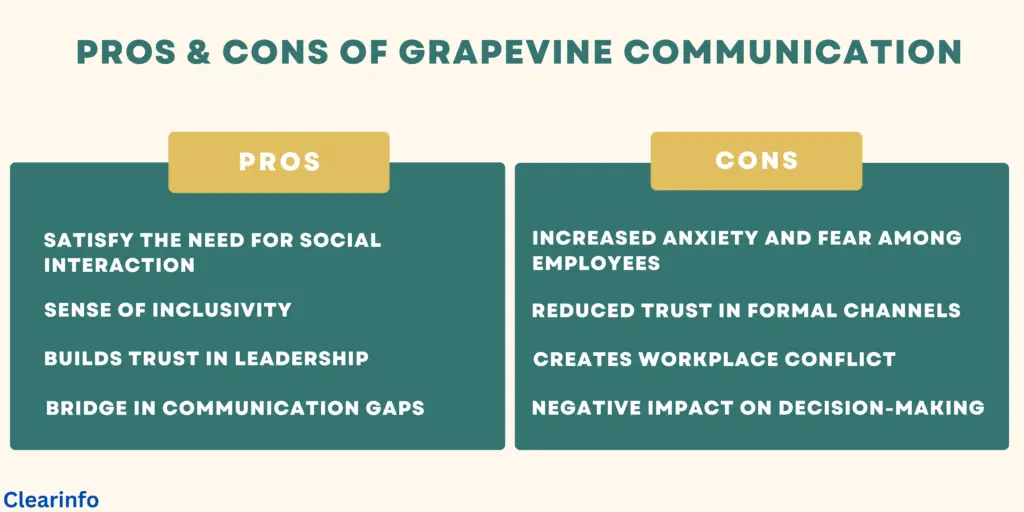
Check out our detailed guide on: Advantages and disadvantages of grapevine communication
Frequently Asked Questions
Q1) What is the other name for grapevine communication?
Ans: Grapevine communication is also known as informal communication. Unlike formal communication, which follows established hierarchical pathways, grapevine communication operates spontaneously and without adherence to organizational structures.
Q2) Grapevine communication is informal or formal?
Ans: Grapevine communication is informal. It operates outside the formal channels of official communication within an organization.
Q3) Why it is called grapevine communication?
Ans: The term “grapevine communication” is used to describe informal communication within an organization due to its similarity to the way grapevines spread and intertwine, forming a complex network.
Q4) Difference between grapevine and rumor?
Ans: Grapevine is an informal communication network in organizations, involving both horizontal and vertical interactions. It can convey factual information and rumors. Rumors, however, are unverified and sensational pieces of information that circulate within the grapevine, often leading to confusion.
Q5) Is grapevine communication helpful in the office?
Ans: Grapevine communication is beneficial to office spaces as it is speedy, and spontaneous and helps boost the morale and coordination of employees. Managers use the grapevine to acquire feedback to make effective business decisions and delegate tasks to subordinates.
Q6) What is grapevine in business communication?
Ans: Grapevine in business communication refers to an informal network of communication that spreads rumors, gossip, and information throughout an organization. It operates outside the formal channels and is characterized by its rapid and sometimes inaccurate transmission of information among employees. The grapevine can move in various directions, including vertical (upward and downward), horizontal, and diagonal interactions.
Q7) Who gave the concept of grapevine communication?
Ans: The origin of the term “grapevine” dates back to the Civil War era, when Army Intelligence used vine-like telegraph wires strung from tree to tree across battlefields. (Kreitner, 1983).

